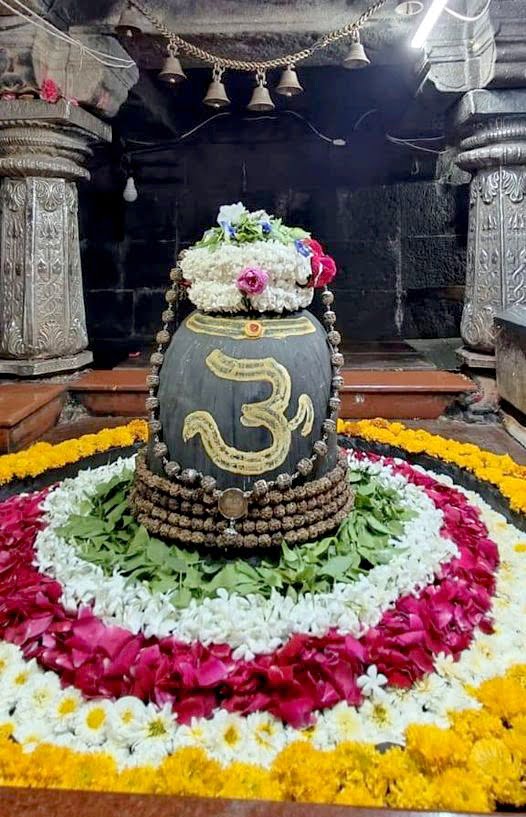Harihareshwar Temple | Kalbhairav Yogeshwari Temple
The Harihareshwar Temple | Kalbhairav Yogeshwari Temple is an ancient Hindu temple located in the Raigad district of Maharashtra, India. It is dedicated to Lord Shiva and is considered to be one of the most sacred Shiva temples in Maharashtra. The temple complex is situated on the banks of the holy river Savitri, which flows into the Arabian Sea here.
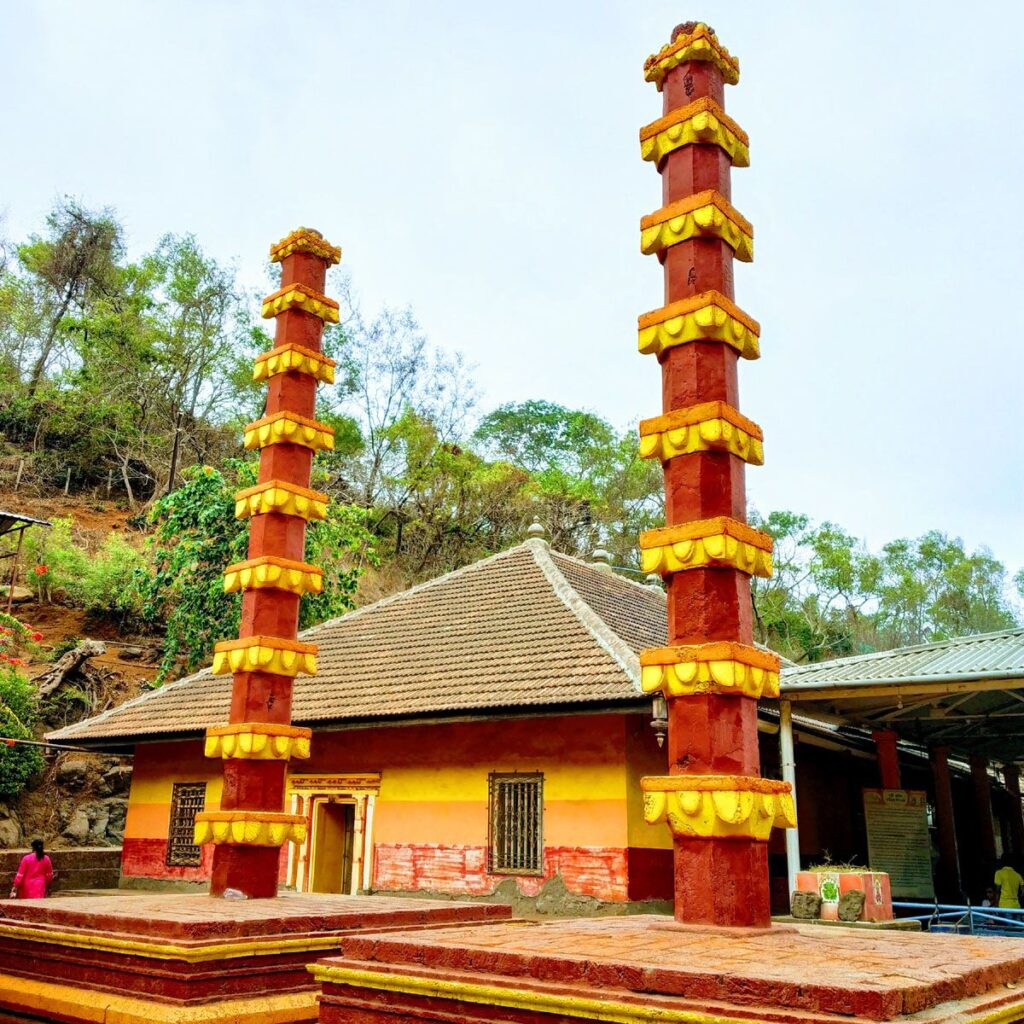
Contents
- 1 Harihareshwar Temple History:
- 2 Legend of Harihareshwar Temple:
- 3 Harihareshwar Temple Architecture:
- 4 Significance of Harihareshwar Temple:
- 5 Harihareshwar Temple Timing & Rituals:
- 5.0.1 Temple Timings:
- 5.0.2 Rituals and Pujas:
- 5.0.3 Sri Bhoga Nandishwara Gudi: Famous 9 Century Nandi’s Abode
- 5.0.4 Nanjundeshwara Temple Mysore | Sri Srikanteshwara Temple
- 5.0.5 Shri Bettada Bhairaveshwara Temple
- 5.0.6 Vittala Temple Hampi
- 5.0.7 Kadri Shree Manjunatha Temple
- 5.0.8 Udupi Sri Krishna Temple: Mathura of South India
- 6 Places to visit near Harihareshwar Temple:
- 6.0.1 1. Diveagar Beach:
- 6.0.2 2. Shrivardhan Beach:
- 6.0.3 3. Bagmandala:
- 6.0.4 4. Bankot Fort:
- 6.0.5 5. Phansad Wildlife Sanctuary:
- 6.0.6 6. Velas Turtle Festival:
- 6.0.7 7. Kondivali Beach:
- 6.0.8 8. Suvarna Ganesh Temple:
- 6.0.9 9. Murud-Janjira Fort:
- 6.0.10 10. Velas Beach:
- 6.0.11 Nageshwar Jyotirlinga Dwaraka: 7th CE Temple with Divine Powers
- 6.0.12 Grishneshwar Temple: Wealth and Pleasure at Shiva’s Feet
- 6.0.13 Kedarnath Temple: One of Jyotirling & Char Dham
- 6.0.14 Trimbakeshwar Jyotirlinga Temple
- 6.0.15 Sacred Kashi Vishwanath Temple: 11th Jyotirling of Liberation
- 6.0.16 Aundha Nagnath Temple: 8th Jyothirling with Divine Serpents
- 7 FAQ:
- 8 How to reach Harihareshwar Temple:
Harihareshwar Temple History:
Ancient Origins:
- Vedic Connection:
- The history of Harihareshwar Temple is believed to date back to the Vedic period. The temple is dedicated to Lord Shiva, known here as Harihareshwar, and is often referred to as the “house of God” due to its divine aura and serene surroundings.
- Mythological Significance:
- According to Hindu mythology, the temple’s site is blessed by the presence of Lord Shiva, Lord Vishnu, and Lord Brahma, making it a significant trinity or Trimurti worship site. This rare combination enhances the temple’s spiritual importance.
Historical Developments:
- Peshwa Era:
- The temple gained prominence during the reign of the Maratha Empire, especially under the Peshwas. Peshwa Balaji Vishwanath, the first Peshwa of the Maratha Empire, is said to have visited the temple, contributing to its restoration and maintenance.
- Architectural Evolution:
- Harihareshwar Temple architecture reflects a blend of ancient and medieval styles. It features intricate carvings, stone sculptures, and a unique sanctum sanctorum. The main deity, Lord Harihareshwar, is enshrined in a typical Hemadpanthi-style structure, which is known for its robust construction using black stone.
Read More>> Kadri Shree Manjunatha Temple
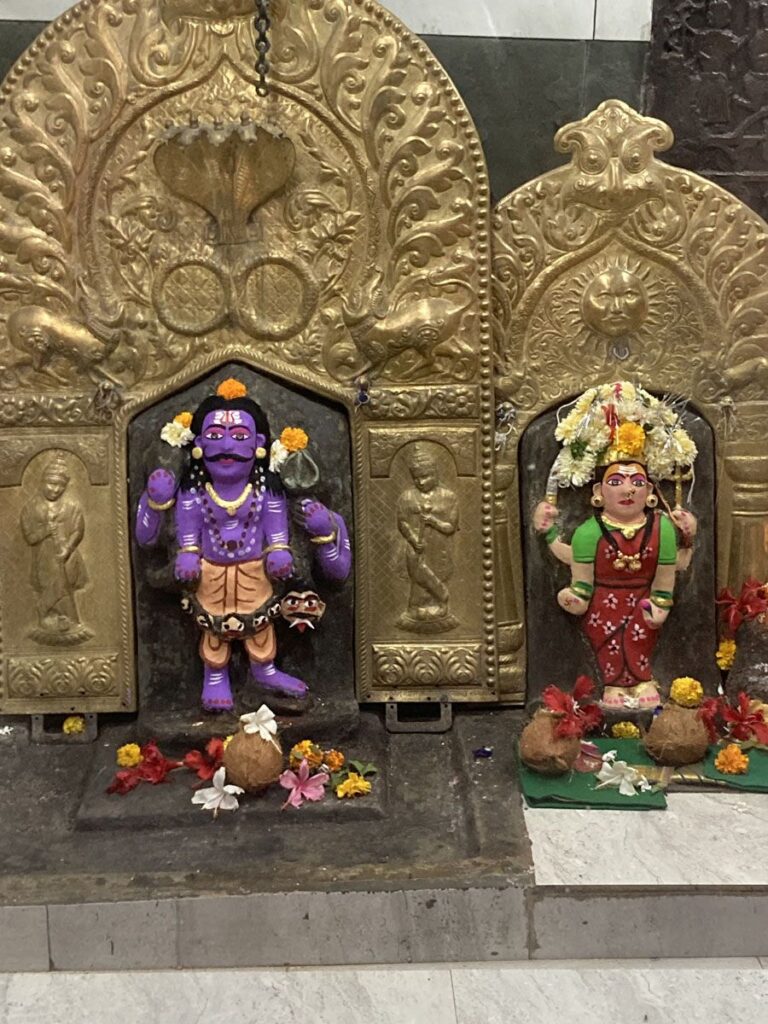
Legend of Harihareshwar Temple:
Divine Origin:
- Creation by the Trinity:
- According to Hindu mythology, the site of Harihareshwar Temple is considered sacred because it is believed to have been blessed by the Hindu trinity—Brahma (the creator), Vishnu (the preserver), and Shiva (the destroyer). This unique confluence is rarely found, making Harihareshwar a powerful spiritual location.
The Curse and Redemption:
- Sage Agastya’s Ashram:
- Legend has it that Sage Agastya, a revered sage in Hindu mythology, established his ashram (hermitage) at the site where the temple now stands. Sage Agastya was known for his wisdom and deep spiritual knowledge.
- Sage’s Curse:
- One day, during his meditation, Sage Agastya was disturbed by a demon named Kaalasura. Enraged by the interruption, the sage cursed Kaalasura, turning him into a stone. This stone is believed to be present near the temple premises and is considered sacred.
The Divine Manifestation:
- Lord Shiva’s Blessing:
- It is believed that Lord Shiva appeared at the site to bless Sage Agastya and sanctify the place. Shiva assured the sage that the location would become a sacred spot for devotees seeking liberation and peace. Consequently, Lord Shiva is worshipped here as Harihareshwar, a name that combines “Hari” (a name for Vishnu) and “Hara” (a name for Shiva).
- Installation of the Shiva Linga:
- According to the legend, Lord Shiva himself manifested as a Shiva Linga at Harihareshwar. This Linga is the primary deity of the temple and is revered by devotees who believe it possesses immense spiritual power.
The Legend of Kalbhairav:
- Guardian Deity:
- Adjacent to the main Harihareshwar Temple is the Kalbhairav Temple, dedicated to Kalbhairav, an incarnation of Lord Shiva. Kalbhairav is considered the guardian deity of the region. The legend states that Kalbhairav was appointed by Shiva to protect the temple and its surroundings, ensuring that devotees could worship in peace.
The Sacred Pradakshina Path:
- Circumambulation Ritual:
- Harihareshwar Temple has a unique Pradakshina path (circumambulation path) that goes around the temple and the rocky cliff by the sea. This path is considered highly auspicious. According to legend, walking along this path can absolve devotees of their sins and bring them closer to divine grace. It symbolizes a journey of purification and spiritual renewal.
Connection with the Pandavas:
- Pandavas’ Visit:
- Another local legend suggests that the Pandavas, the five brothers from the epic Mahabharata, visited Harihareshwar during their exile. It is believed that they performed rituals and sought blessings from Lord Shiva at this site.
Read More>> Mahalakshmi Temple Kolhapur | Ambabai Temple
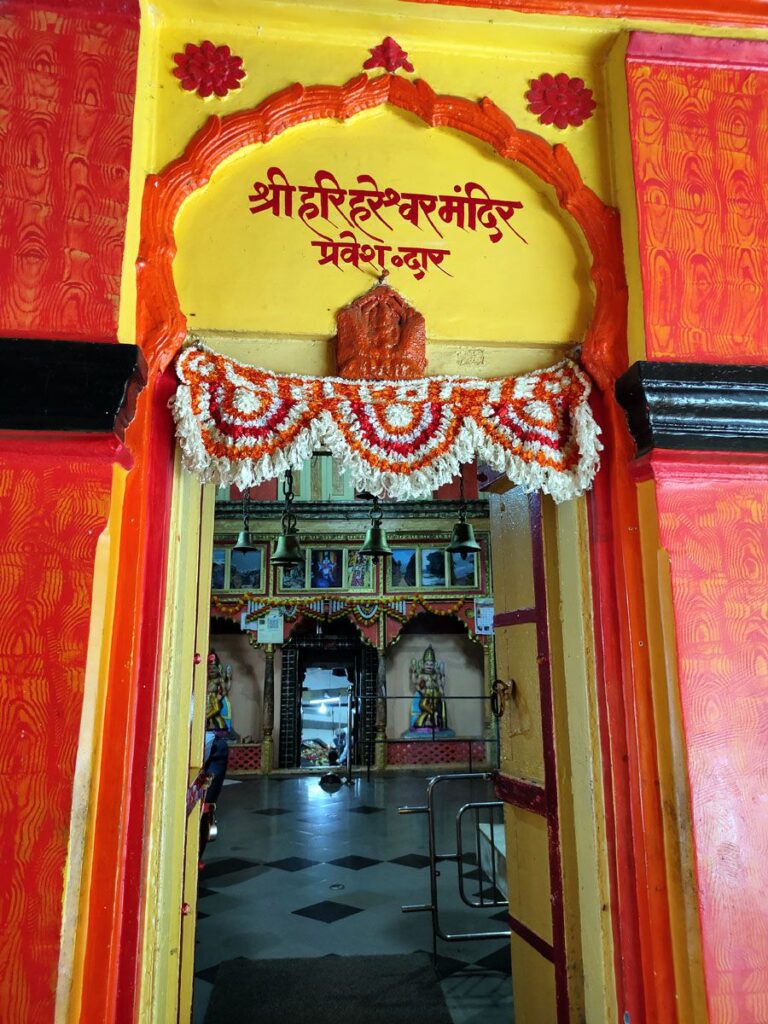
Harihareshwar Temple Architecture:
Hemadpanthi Style:
- Stone Construction:
- The temple is primarily constructed using locally sourced black stone, which is characteristic of the Hemadpanthi architectural style. This style is prevalent in the Maharashtra region and is known for its sturdy and durable construction.
- Simplicity and Symmetry:
- Hemadpanthi architecture emphasizes simplicity and symmetry in design. The Harihareshwar Temple follows this principle with its straightforward layout and balanced proportions.
Temple Structure:
- Main Sanctum (Garbhagriha):
- The main sanctum of the temple houses the presiding deity, Lord Harihareshwar (Shiva), in the form of a Shiva Linga. The sanctum is square-shaped and is accessed through a carved entrance adorned with intricate motifs.
- Mandapa:
- A mandapa (pillared hall) serves as an assembly area for devotees and a space for conducting rituals and ceremonies. The mandapa is supported by stone pillars and features detailed carvings on the ceiling and walls.
Architectural Elements:
- Carvings and Sculptures:
- Harihareshwar Temple is adorned with intricate carvings and sculptures depicting mythological motifs, deities, celestial beings, and floral patterns. These carvings add aesthetic beauty to the temple and convey symbolic meanings.
- Doorway (Torana):
- The entrance to the sanctum is embellished with a torana (decorative archway) featuring elaborate carvings. The torana serves as a transition between the outer world and the sacred space of the sanctum.
Additional Features:
- Kalbhairav Temple:
- Adjacent to the main temple is the Kalbhairav Temple, dedicated to Kalbhairav, an incarnation of Lord Shiva. The architectural style of this temple complements that of the main Harihareshwar Temple.
- Pradakshina Path:
- The temple complex includes a Pradakshina path (circumambulation route) that encircles the main sanctum and the rocky cliffs by the sea. The path is lined with stone railings and offers panoramic views of the surroundings.
Preservation and Restoration:
- Conservation Efforts:
- Over the years, efforts have been made to preserve and restore the architectural integrity of Harihareshwar Temple. Conservation projects aim to maintain the temple’s historical and cultural significance for future generations.
- Modern Amenities:
- While preserving its ancient architectural charm, the temple also incorporates modern amenities such as lighting, ventilation, and facilities for devotees’ comfort and convenience.
Read More>> Sri Kukke Subramanya Temple: Lord of Serpents
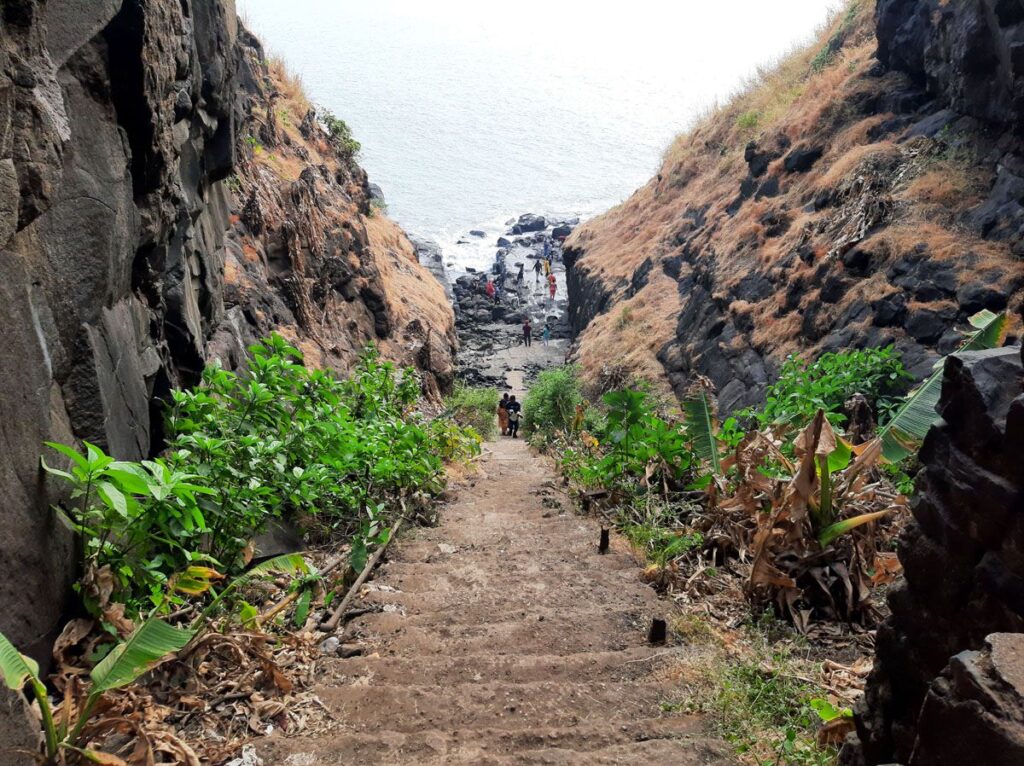
Significance of Harihareshwar Temple:
Religious Significance:
Dedicated to Shiva: As a temple dedicated to Lord Shiva, one of the principal deities in Hinduism, Harihareshwar holds immense religious importance for Hindus, particularly those in Maharashtra. The presence of a self-originated (Swayambhu) Shiva linga further elevates its sanctity.
Union of Vishnu and Shiva: The name “Harihareshwar” itself is a combination of “Hari” (Vishnu) and “Hara” (Shiva), symbolizing the harmonious union of these two important gods. This unique aspect makes the temple a significant pilgrimage site for devotees seeking blessings from both deities.
Shravan Month Significance: Performing puja at Harihareshwar Temple during the holy month of Shravan is believed to bring immense spiritual merit (punya) to devotees.
Historical Significance:
Medieval Marvel: The temple’s construction dates back to the late medieval period, making it a historical landmark that offers a glimpse into the architectural and artistic styles of that era.
Peshwa Connection: The temple was patronized by the Peshwas, the prime ministers of the Maratha Empire. This association adds to the temple’s historical significance and reflects its connection to a powerful Maratha dynasty.
Cultural Significance:
Location on the Savitri River: Situated on the banks of the holy Savitri River, which merges with the Arabian Sea here, the temple’s location holds cultural significance. The confluence of river and sea is considered sacred in Hinduism, and the temple’s presence at this point adds to its spiritual allure.
Peaceful Atmosphere: The serene location and beautiful surroundings create a peaceful atmosphere that attracts devotees seeking spiritual solace and rejuvenation.
Read More>> Vadapalli Temple of Sri Venkateswara Swamy

Harihareshwar Temple Timing & Rituals:
Temple Timings:
- Morning: 5:30 AM to 12:00 PM
- Afternoon Break: 12:00 PM to 4:00 PM
- Evening: 4:00 PM to 8:30 PM
Please note that these timings are approximate and may vary depending on the specific rituals and festivals.
Rituals and Pujas:
- Morning Rituals:
- Harihareshwar Temple opens early in the morning for devotees to offer prayers and perform rituals. Morning aarti (worship with lamps) and abhishekam (ritual bathing of the deity) are conducted to commence the day’s worship.
- Midday Break:
- During the afternoon break, the temple remains closed for cleaning and maintenance. Devotees can still visit the temple premises for meditation or relaxation.
- Evening Rituals:
- The temple reopens in the late afternoon for evening prayers and rituals. Evening aarti and abhishekam are performed, attracting devotees who seek blessings and spiritual solace after the day’s activities.
- Special Pujas and Festivals:
- On auspicious occasions such as Maha Shivaratri, Diwali, and other major festivals, special pujas and rituals are conducted at the temple. These events draw large crowds of devotees who gather to participate in the celebrations and seek divine blessings.
- Pradakshina Path:
- Devotees often undertake the Pradakshina path, a circumambulation route around the temple and the rocky cliffs by the sea. This ritual involves walking clockwise around the temple, symbolizing reverence and devotion towards the deity.
- Kalbhairav Temple Rituals:
- Adjacent to the main temple, the Kalbhairav Temple conducts its own rituals and pujas. Devotees visit Harihareshwar Temple to seek blessings from Kalbhairav, another form of Lord Shiva.
- Daily Offerings:
- Throughout the day, devotees offer flowers, fruits, coconuts, and other symbolic items to the deity as a sign of devotion and gratitude. Prasad (sacred food offering) is distributed to devotees after the rituals.
- Personal Pujas:
- Devotees can also book personal pujas for special occasions such as birthdays, anniversaries, or specific prayers for blessings and protection.
Places to visit near Harihareshwar Temple:
1. Diveagar Beach:
- Located around 20 kilometers from Harihareshwar, Diveagar Beach is known for its pristine shoreline, clear waters, and tranquil atmosphere. It’s an ideal spot for relaxation and water activities.
2. Shrivardhan Beach:
- Shrivardhan Beach, situated approximately 15 kilometers away, is another picturesque beach known for its golden sands and scenic beauty. It offers opportunities for swimming, sunbathing, and enjoying breathtaking sunsets.
3. Bagmandala:
- Bagmandala is a small fishing village near Harihareshwar, known for its rustic charm and traditional way of life. Visitors can experience the local culture, interact with fishermen, and explore the quaint surroundings.
4. Bankot Fort:
- Bankot Fort, also known as Himmatgad Fort, is located near Harihareshwar. This historic fort offers panoramic views of the surrounding landscape and provides insights into the region’s architectural and military history.
5. Phansad Wildlife Sanctuary:
- Phansad Wildlife Sanctuary, situated approximately 30 kilometers away, is a haven for nature lovers and wildlife enthusiasts. It is home to diverse flora and fauna, including rare species of birds, mammals, and reptiles.
6. Velas Turtle Festival:
- Velas, a coastal village near Harihareshwar, hosts the annual Velas Turtle Festival during the nesting season of Olive Ridley sea turtles. Visitors can witness the release of baby turtles into the sea and learn about conservation efforts.
7. Kondivali Beach:
- Kondivali Beach, located close to Harihareshwar, is known for its rocky terrain and scenic beauty. It’s a peaceful retreat where visitors can enjoy solitude amidst nature.
8. Suvarna Ganesh Temple:
- Suvarna Ganesh Temple, situated in Diveagar, is a revered Hindu temple dedicated to Lord Ganesha. The temple is known for its golden idol of Lord Ganesha and attracts devotees from far and wide.
9. Murud-Janjira Fort:
- Murud-Janjira Fort, located a bit further away, is a famous sea fort known for its architectural grandeur and historical significance. Visitors can explore the fort’s ruins and learn about its maritime history.
10. Velas Beach:
- Velas Beach is a serene and less-crowded beach near Harihareshwar, offering tranquility and solitude amidst natural surroundings.
FAQ:
1. Where is Harihareshwar Temple located?
- Harihareshwar Temple is situated in the town of Harihareshwar in the Raigad district of Maharashtra, India. It is located on the Konkan coast, overlooking the Arabian Sea.
2. What are the temple timings?
- The temple timings are generally from early morning to late evening. Specific timings may vary, so it’s advisable to check with local authorities or the temple office.
3. What is the significance of Harihareshwar Temple?
- Harihareshwar Temple is significant for its association with Lord Shiva and its location at the confluence of Brahma, Vishnu, and Shiva. It is considered a sacred pilgrimage site where devotees seek blessings for spiritual fulfillment and liberation.
4. Are there any rituals performed at the temple?
- Yes, the temple conducts various rituals and pujas throughout the day, including morning and evening aartis, abhishekam (ritual bathing of the deity), and special pujas on auspicious occasions and festivals.
5. What is the Pradakshina path?
- The Pradakshina path is a circumambulation route around the temple and the rocky cliffs by the sea. Devotees walk along this path as a form of worship and penance, symbolizing reverence and devotion towards the deity.
6. Are there any festivals celebrated at Harihareshwar Temple?
- Yes, Harihareshwar Temple celebrates various festivals, including Maha Shivaratri, Diwali, and other major Hindu festivals. These festivals are marked by special rituals, pujas, and cultural events, attracting devotees and tourists.
7. What are the nearby attractions to visit?
- Nearby attractions include Diveagar Beach, Shrivardhan Beach, Bankot Fort, Phansad Wildlife Sanctuary, and the Velas Turtle Festival, among others. These attractions offer opportunities for sightseeing, nature exploration, and cultural experiences.
8. Can personal pujas be booked at the temple?
- Yes, devotees have the option to book personal pujas for special occasions or specific prayers. This can be arranged through the temple office or with the assistance of the temple priests.
9. Is there an entry fee to visit the temple?
- No, there is no entry fee to visit Harihareshwar Temple. However, donations are welcome and appreciated for the maintenance and upkeep of the temple premises.
10. What facilities are available at the temple?
- The temple provides basic facilities such as restrooms, drinking water, and a prasad counter. During festivals and special events, additional arrangements may be made for devotees’ convenience.
How to reach Harihareshwar Temple:
By Road:
- From Mumbai:
- Distance: Approximately 210 kilometers
- Route: Take the Mumbai-Goa Highway (NH66) via Panvel, Mangaon, and Mhasala. Then, follow the signs to Harihareshwar.
- Travel Time: Around 4.5 to 5 hours by car.
- From Pune:
- Distance: Approximately 170 kilometers
- Route: Take the Pune-Bangalore Highway (NH48) towards Kolhapur. Then, continue on NH66 via Satara, Mahad, and Mhasala to reach Harihareshwar.
- Travel Time: Approximately 4 to 4.5 hours by car.
- From Goa:
- Distance: Approximately 330 kilometers
- Route: Take the Mumbai-Goa Highway (NH66) via Panaji, Mapusa, and Chiplun. Then, follow the signs to Harihareshwar.
- Travel Time: Around 7 to 8 hours by car.
By Bus:
- State-run and private buses operate from major cities like Mumbai, Pune, and Goa to nearby towns such as Shrivardhan and Diveagar. From there, you can hire local taxis or auto-rickshaws to reach Harihareshwar Temple.
By Train:
- The nearest railway station to Harihareshwar is Mangaon Railway Station, located approximately 60 kilometers away. From there, you can hire a taxi or take a bus to reach Harihareshwar.
By Air:
- The nearest airport to Harihareshwar is Chhatrapati Shivaji Maharaj International Airport in Mumbai, which is well-connected to major cities across India and abroad. From the airport, you can hire a taxi or take a bus to reach Harihareshwar via the road route mentioned above.












